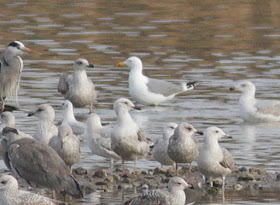A good haul of gulls this morning with ten species:
2 juv/first-winter Glaucous, 1 first-winter Iceland, 4 Caspian Gull (1 2nd-winter, 3 first-winter), I adult Yellow-legged Gull, 1 ad Med Gull, 100+ Lesser Black-backed, 8000+ Herring Gull, 20+ Great Black-backed, 10 Common Gull and 2000+ Black-headed Gull.
Also two additional taxa argentatus Herring Gull and Lesser Black-back backed both intermedius and graellsii.
Plenty of turnover of gulls at the moment with migrating flocks moving over high and some coming down. A great time of year to find a mega gull with so much traffic moving through.
Glaucous Gull #1
Glaucous Gull #2
Bird #2 has a distinctive pale head and nape contrasting with the lower nape and upper breast.
Bird 1 is more uniform. Difficult to conclude (due to moult and wear) whether either of these is the same as the bird that was first seen in December HERE but the December bird was a real monster with what appeared to be a disproportionately short bill- presumably young birds can change a lot in a few months. Both birds were seen coming out the roost at Walton Res this morning by Dave Harris.
The juv/first-winter Iceland Gull with the contrasting primaries has been comparatively easy to track and has been present since late November. It's also been seen by Josh on the Thames and Dave at Walton. HERE
Second-winter Caspian Gull. Following an influx in December/January, there have been relatively few records until today with at least four birds on the Northern Lake.
Adult Mediterranean Gull. An increasing rare visitor to the farmlands- the first one I've seen this year. Previously a winter visitor in small numbers.
Adult Yellow-legged Gull - up to five present recently
68 Barnacle Geese moving north-west today. The first record of a flock over the farmlands looking rather wild. Difficult to rule out a feral group moving around though.
Still five Wigeon around.
Up to 8 Jack Snipe recently and 120 Snipe.
At last some moths in the trap. Common Quakers and March Moth. Typical early spring moths.
Mompha subbistrigella - a classic early micro.
















No comments:
Post a Comment